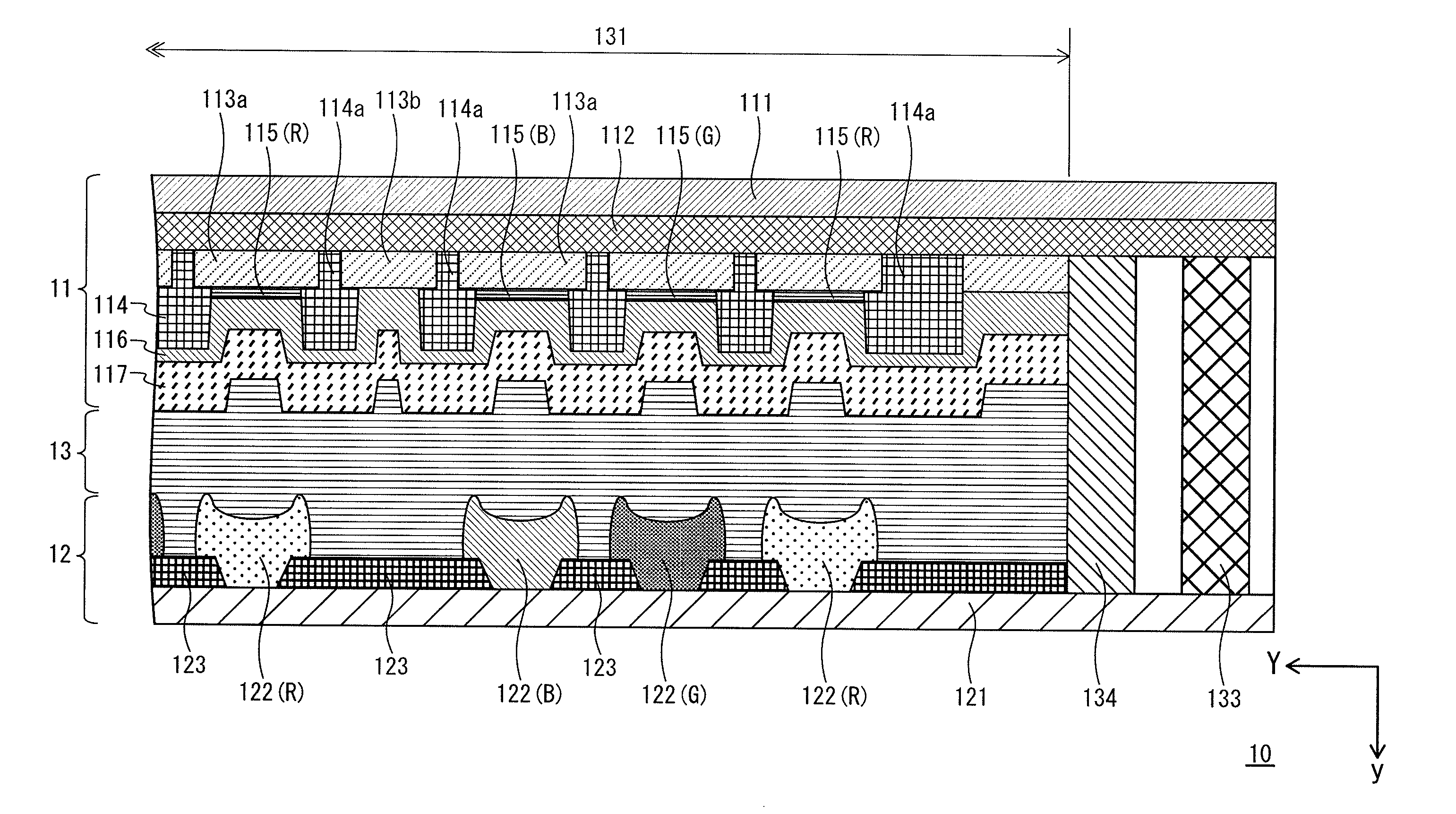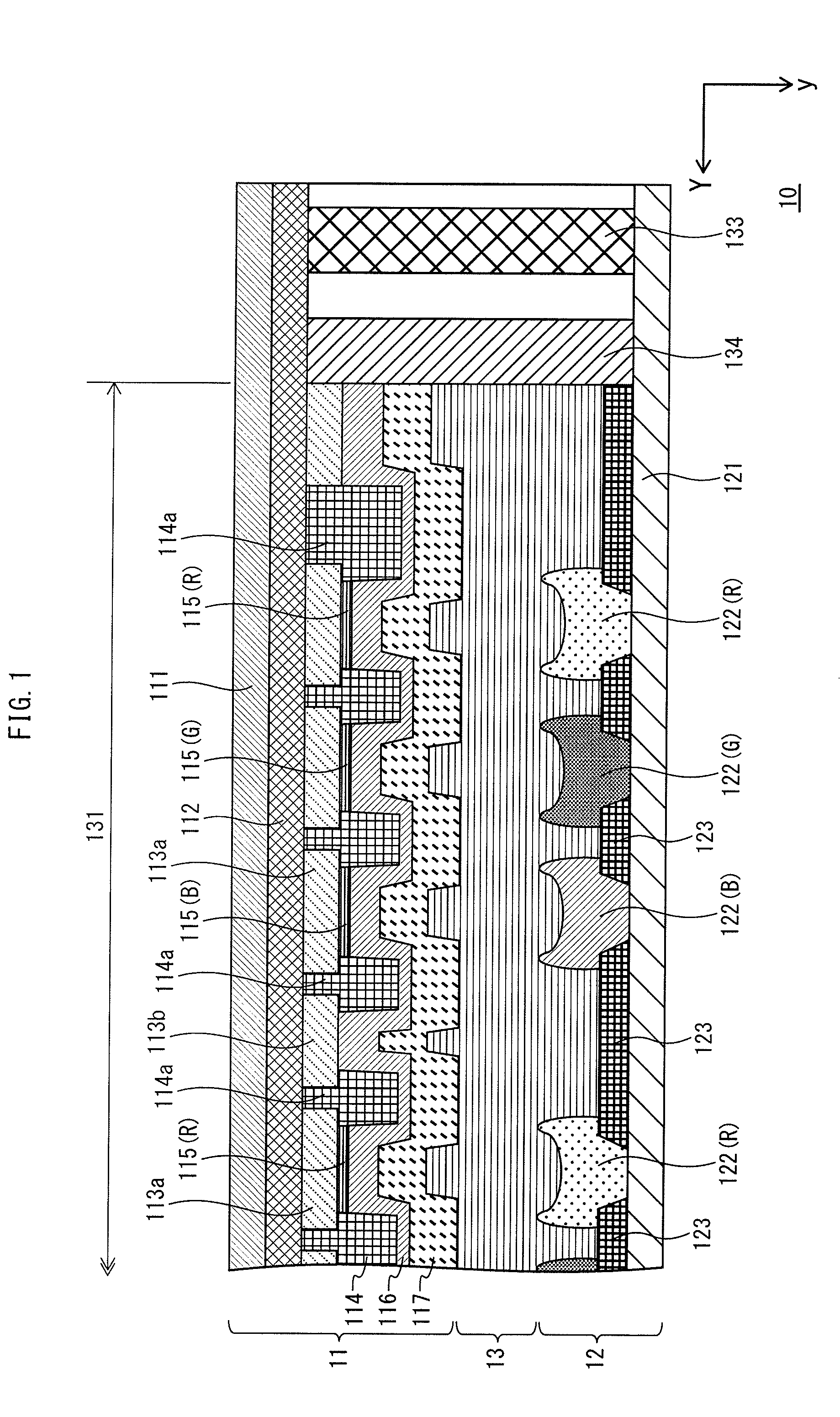Display panel and display panel manufacturing method
a technology for display panels and manufacturing methods, applied in the field of display panels, can solve the problems of deterioration in the properties of organic el elements, high instability of the material used for the structure of organic el laminates, and the inability to manufacture electrode systems, etc., to achieve yield optimization, improve manufacturing efficiency, and reduce the amount of protruding corners of rectangular frames
- Summary
- Abstract
- Description
- Claims
- Application Information
AI Technical Summary
Benefits of technology
Problems solved by technology
Method used
Image
Examples
embodiment 1
1. Configuration
(1) Overall Configuration
[0049]FIG. 1 is a partial cross-sectional diagram schematically illustrating key portions of a display panel 10 pertaining to Embodiment 1.
[0050]As shown, the display panel 10 includes an EL substrate 11 and a colour filter (hereinafter also CF) substrate 12, as well as a sealing resin layer 13 interposed between the EL substrate 11 and the CF substrate 12.
[0051]The sealing resin layer 13 is provided and applied in liquid form and then cured, with the aims of conjoining the EL substrate 11 and the CF substrate 12 and of protecting the EL substrate 11 from infiltration by water and gas from outside the display panel 10. However, the sealing resin layer 13 is not strictly necessary and may be omitted from the configuration.
[0052]Light exits the display panel 10 from the top or front. However, with respect to FIG. 1, light exits from the bottom as drawn.
(2) EL Substrate
[0053]The EL substrate 11 is made up of a substrate, an inter-layer insulatio...
embodiment 2
[0163]As shown in FIG. 13, Embodiment 1 describes cutting the EL substrate and the CF substrate to identical dimensions. That is, the cut face (i.e., side face) of the EL substrate and the cut face (i.e., side face) of the CF substrate are cut so as to match along the entire respective perimeters thereof.
[0164]However, the EL substrate and the CF substrate may differ in terms of dimensions. Embodiment 2 describes an example of such a case (i.e., where the cut faces do not match).
1. Mono-Panel Method
[0165]FIGS. 16A and 16B illustrate an example pertaining to Embodiment 2 in which the display panel has substrates of different dimensions. FIG. 16A is a plan view of the display panel and FIG. 16B is a magnified perspective view of a corner of the intermediate panel.
(1) Overview
[0166]A display panel 300 has a display region 302 sealed by a sealing member 305 when an EL substrate 301 and a CF substrate 303 are joined to each other. As indicated by the dashed line in FIG. 16A, the sealing ...
example 1
(a) Example 1
[0225]As shown in FIG. 21A, reinforced portion 501 pertaining to Example 1 is arranged at the outside of a corner portion 505 of rectangular frame 503 so as to be continuous with the corner portion 505. The reinforced portion 501 is round as seen in the plan view, and the interior thereof is not filled by the frit paste.
[0226]The reinforced portion 501 is formed so as to bridge edge portion 507 and edge portion 509, which meet at corner portion 505 of the rectangular frame 503. In other words, the reinforced portion 501 is formed so as to extend from one edge portion of the corner portion 505 (e.g., edge portion 507) and curve in a circle before continuing to the other edge portion (e.g., edge portion 509).
[0227]According to this configuration, the frit paste is applied with a single stroke, thus enabling more efficient frit paste application.
PUM
 Login to View More
Login to View More Abstract
Description
Claims
Application Information
 Login to View More
Login to View More - R&D
- Intellectual Property
- Life Sciences
- Materials
- Tech Scout
- Unparalleled Data Quality
- Higher Quality Content
- 60% Fewer Hallucinations
Browse by: Latest US Patents, China's latest patents, Technical Efficacy Thesaurus, Application Domain, Technology Topic, Popular Technical Reports.
© 2025 PatSnap. All rights reserved.Legal|Privacy policy|Modern Slavery Act Transparency Statement|Sitemap|About US| Contact US: help@patsnap.com



